Paper Menu >>
Journal Menu >>
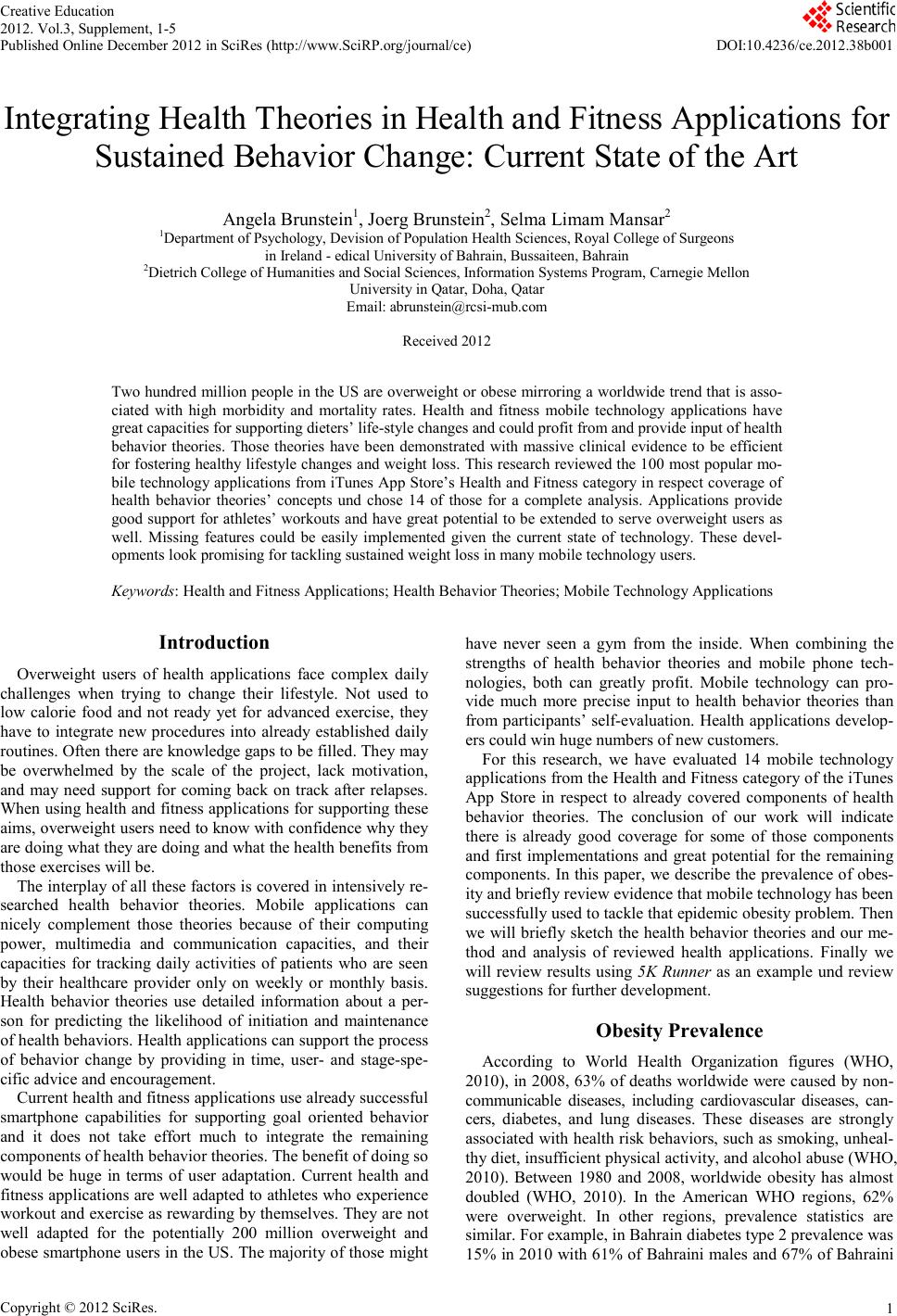 Creat ive Educati on 2012. Vol.3, Supplement, 1-5 Published Online December 2012 in SciRes (http://www.SciRP.org/journal/ce) DOI:10.4236/ce.2012.38b001 Copyright © 2012 SciRes. 1 Integrating Health Theories in Health and Fitness Applications for Sustained Behavior Change: Current State of the Art Angela Brunstein1, Joerg Brunstein2, Selma Limam Mansar2 1Department of Psychology, Devisi on of Popu lation Health Sciences, Royal College of Surgeons in Ireland - edical University of Bahrain, Bussaiteen, Bahrain 2Dietrich College of Humanities and Social Sciences, Information Systems Program, Carnegie Mellon University in Qatar, Doha, Qatar Email: abrunstein@rcsi-mub.com Received 20 1 2 Two hundre d mill ion peopl e in the US ar e overweig ht or obes e mirroring a worldwi de trend tha t is asso- ciated with high morbidity and mortality rates. Health and fitness mobile technology applications have great capacities for support ing dieter s’ life-st yle changes and could p rofit from a nd provide i nput of health behavior theories. Those theories have been demonstrated with massive clinical evidence to be efficient for f ostering hea lthy lif estyle cha nges and w eight los s. This research re viewed the 10 0 most p opular mo- bil e technolog y appl ications from iTunes App St ore’s Hea lth and Fit ness ca tegory in r espect coverage of health behavior theories’ concepts und chose 14 of those for a complete analysis. Applications provide good sup port for at hletes’ work outs and have great potential to be extended to s erve overweight users as well. Missing features could be easily implemented given the current state of technology. These devel- opments look promising for tackling sustained weight loss in many mobile technology users . Keywords: Health and Fitness Applications; Heal th Behavior Theories; Mobile Technology Applications Introduction Overweight users of health applications face complex daily challenges when trying to change their lifestyle. Not used to low calorie food and not ready yet for advanced exercise, they have to integrate new procedures into already established daily routines. Often there are knowledge gaps to be filled. They may be overwhelmed by the scale of the project, lack motivation, and may need support for coming back on track after relapses. When using health and fitness applications for supporting these aims, overweight users need to know with confidence why they are doing what they are doing and what the health benefits from tho se exer cises will b e. The i nterp lay of all these factors is covered in intensively re- searched health behavior theories. Mobile applications can nicely complement those theories because of their computing power, multimedia and communication capacities, and their capacities for tracking daily activities of patients who are seen by their healthcare provider only on weekly or monthly basis. Health behavior theories use detailed information about a per- son for predicting the likelihood of initiation and maintenance of health b ehavio rs. Health applications can support the process of behavior change by providing in time, user- and stage-spe- cific advic e and encouragement. Curren t health and fitness appli cations use alread y successful smartphone capabilities for supporting goal oriented behavior and it does not take effort much to integrate the remaining components of health behavior theories. The benefit of doing so would be huge in terms of user adaptation. Current health and fitness ap plication s are well adapted to athl etes who experien ce workout an d exercise as rewardin g by the mselves. The y are not well adapted for the potentially 200 million overweight and obese smartphone users in the US. The majority of those might have never seen a gym from the inside. When combining the strengths of health behavior theories and mobile phone tech- nologies, both can greatly profit. Mobile technology can pro- vide much more precise input to health behavior theories than from participants’ self-evaluatio n. Health app lications develop- ers could win huge numbers of new customers. For this research, we have evaluated 14 mobile technology applications from the Health and Fitness category of the iTunes App Store in respect to already covered components of health behavior theories. The conclusion of our work will indicate there is already good coverage for some of those components and first implementations and great potential for the remaining components. In this paper, we describe the prevalence of obes- ity and b r iefly review evidence th at mobile tech nology has been successfu ll y used t o tackle t hat epidemic obes ity pro bl em. Then we will briefly sketch the health behavior theories and our me- thod and analysis of reviewed health applications. Finally we will review results using 5K Runner as an example und review suggestions for further development. Obesity Prev alen ce According to World Health Organization figures (WHO, 2010), in 2008, 63% of deaths worldwide were caused by non- communicable diseases, including cardiovascular diseases, can- cers, diabetes, and lung diseases. These diseases are strongly associated with health risk behaviors, such as smoking, unheal- thy diet, insufficient physical activity, and alcohol abuse (WHO, 2010). Between 1980 and 2008, worldwide obesity has almost doubled (WHO, 2010). In the American WHO regions, 62% were overweight. In other regions, prevalence statistics are similar. For example, in Bahrain diabetes type 2 prevalence was 15% in 2010 with 61% of Bahraini males and 67% of Bahraini 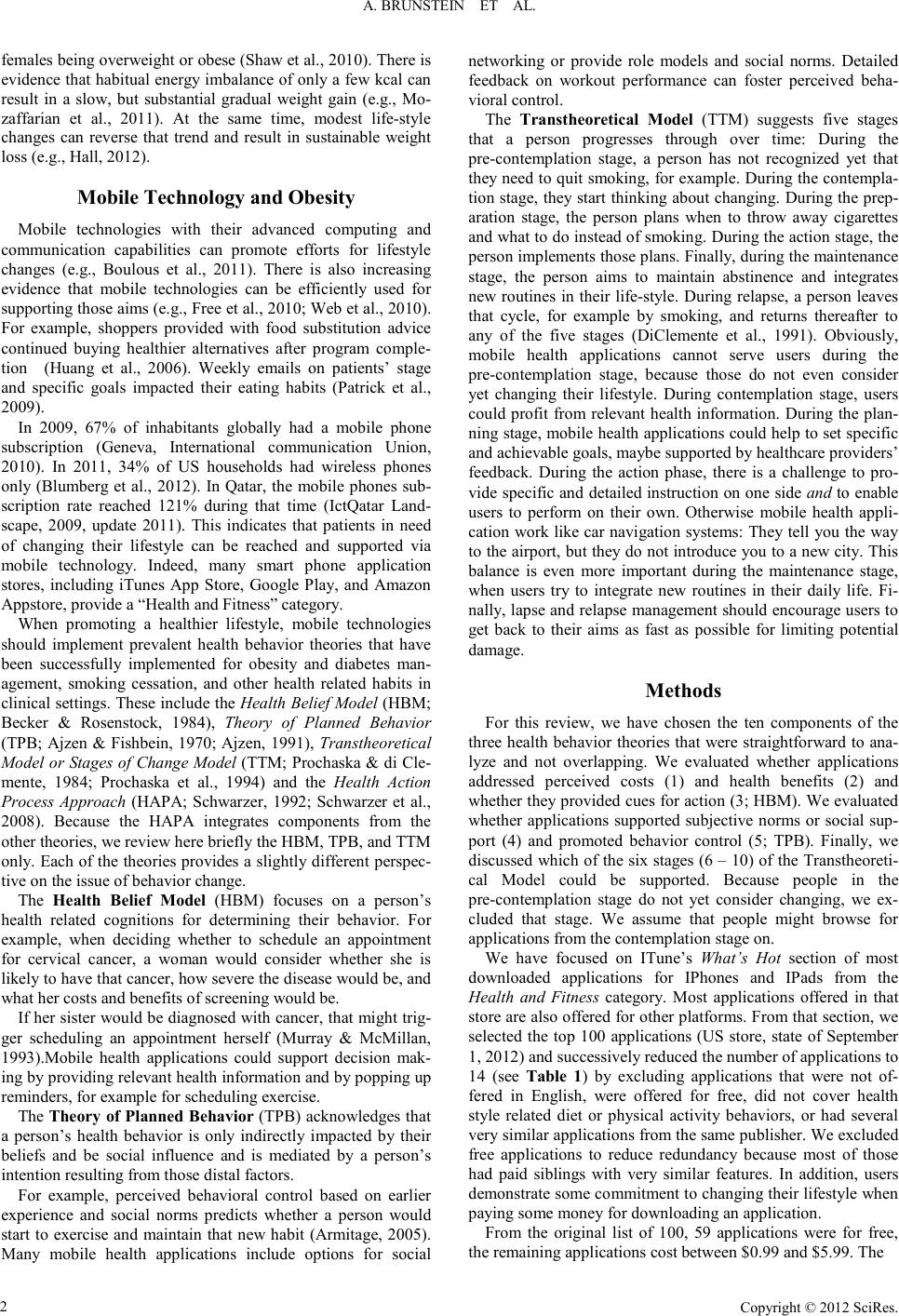 A. BR UNS TEIN ET AL. Copyright © 2012 SciRes. 2 females bei ng o ver weight or obese (Sh aw et al., 201 0) . Ther e is evidence t hat habi tual ener gy imb alance of on ly a few kcal can result in a slow, but substantial gradual weight gain (e.g., Mo- zaffarian et al., 2011). At the same time, modest life-style changes can reverse that trend and result in sustainable weight loss (e.g., Hall, 2012). Mobile Technology and Obesity Mobile technologies with their advanced computing and communication capabilities can promote efforts for lifestyle changes (e.g., Boulous et al., 2011). There is also increasing evidence that mobile technologies can be efficiently used for supporting those aims (e.g., Free et al., 2010; Web et al., 2010). For example, shoppers provided with food substitution advice continued buying healthier alternatives after program comple- tion (Huang et al., 2006). Weekly emails on patients’ stage and specific goals impacted their eating habits (Patrick et al., 2009). In 2009, 67% of inhabitants globally had a mobile phone subscription (Geneva, International communication Union, 2010). In 2011, 34% of US households had wireless phones only (Blumberg et al., 2012). In Qatar, the mobile phones sub- scription rate reached 121% during that time (IctQatar Land- scape, 2009, update 2011). This indicates that patients in need of changing their lifestyle can be reached and supported via mobile technology. Indeed, many smart phone application stores, including iTunes App Store, Google Play, and Amazon Appsto re, provide a “H ealth and Fitness” category. When promoting a healthier lifestyle, mobile technologies should implement prevalent health behavior theories that have been successfully implemented for obesity and diabetes man- agement, smoking cessation, and other health related habits in clinical settings. These include the Health Belief Model (HBM; Becker & Rosenstock, 1984), Theory of Planned Behavior (TPB; Ajzen & Fishbein, 1970; Ajzen, 1991), Transtheoretical Model or Stages of Change Model (TTM; Proch aska & di Cle- mente, 1984; Prochaska et al., 1994) and the Health Action Process Approach (HAPA; Schwarzer, 1992; Schwarzer et al., 2008). Because the HAPA integrates components from the oth er th eories, we review here briefly the HBM, TPB, and TTM only. Each of the theories provides a slightly different perspec- tive on the issue of behavior change. The Health Belief Model (HBM) focuses on a person’s health related cognitions for determining their behavior. For example, when deciding whether to schedule an appointment for cervical cancer, a woman would consider whether she is likel y to have that cancer, ho w severe the d isease wou ld b e, and what her costs and benefits of screening would be. If her sister would be diagnosed with cancer, that might trig- ger scheduling an appointment herself (Murray & McMillan, 1993).Mobile health applications could support decision mak- ing by providing relevant health information and by popping up reminders, for example for s cheduling exercise. The Theory of Pl anned Beha vior (TPB) ackno wledges t hat a person’s health behavior is only indirectly impacted by their beliefs and be social influence and is mediated by a person’s intention resulting from those distal factors. For example, perceived behavioral control based on earlier experience and social norms predicts whether a person would start to exercise and maintain that new habit (Armitage, 2005). Many mobile health applications include options for social networking or provide role models and social norms. Detailed feedback on workout performance can foster perceived beha- vioral control. The Transtheoretical Model (TTM) suggests five stages that a person progresses through over time: During the pre-contemplation stage, a person has not recognized yet that they need to quit smoking, for example. During the contempla- tion stage, they start thinking about changing. During the prep- aration stage, the person plans when to throw away cigarettes and what to do instead of smoking. During the action stage, the person implements those plans. Finally, during the maintenance stage, the person aims to maintain abstinence and integrates new routines in their life-style. During relapse, a person leaves that cycle, for example by smoking, and returns thereafter to any of the five stages (DiClemente et al., 1991). Obviously, mobile health applications cannot serve users during the pre-contemplation stage, because those do not even consider yet changing their lifestyle. During contemplation stage, users could profit from relevant health information. During the plan- ning stage, mobile health applications could help to set specific and achievable goals, maybe supported by healthcare providers’ feedback. During the action phase, there is a challenge to pro- vide specific and detailed instruction on one side and to enable users to perform on their own. Otherwise mobile health appli- cation work like car navigation systems: They tell you the way to the airport, but they do not introduce you to a new city. This balance is even more important during the maintenance stage, when users try to integrate new routines in their daily life. Fi- nally, lap se and relap se managemen t shou ld encourage us ers to get back to their aims as fast as possible for limiting potential damage. Methods For this review, we have chosen the ten components of the three h ealth behavior t heories that were st raightforward t o ana- lyze and not overlapping. We evaluated whether applications addressed perceived costs (1) and health benefits (2) and whether they provided cues for action (3; HBM). We evaluated whether applications supported subjective norms or social sup- port (4) and promoted behavior control (5; TPB). Finally, we discussed which of the six stages (6 – 10) of the Transtheoreti- cal Model could be supported. Because people in the pre-contemplation stage do not yet consider changing, we ex- cluded that stage. We assume that people might browse for applications from the contemplation st a ge on. We have focused on ITune’s What’s Hot section of most downloaded applications for IPhones and IPads from the Health and Fitness category. Most applications offered in that store are also offered for other platforms. From that section, we selected the top 100 applications (US store, state of September 1, 2012) and successively reduced the number of applications to 14 (see Table 1) by excluding applications that were not of- fered in English, were offered for free, did not cover health style related diet or physical activity behaviors, or had several very similar ap pl icat io ns fro m the same p ub lish er. We exclu ded free applications to reduce redundancy because most of those had paid siblings with very similar features. In addition, users demonstr ate some co mmitment t o chan ging their lifestyle when paying some money for downloading an application. From the original list of 100, 59 applications were for free, the remaining applications cost between $0.99 and $5.99. The 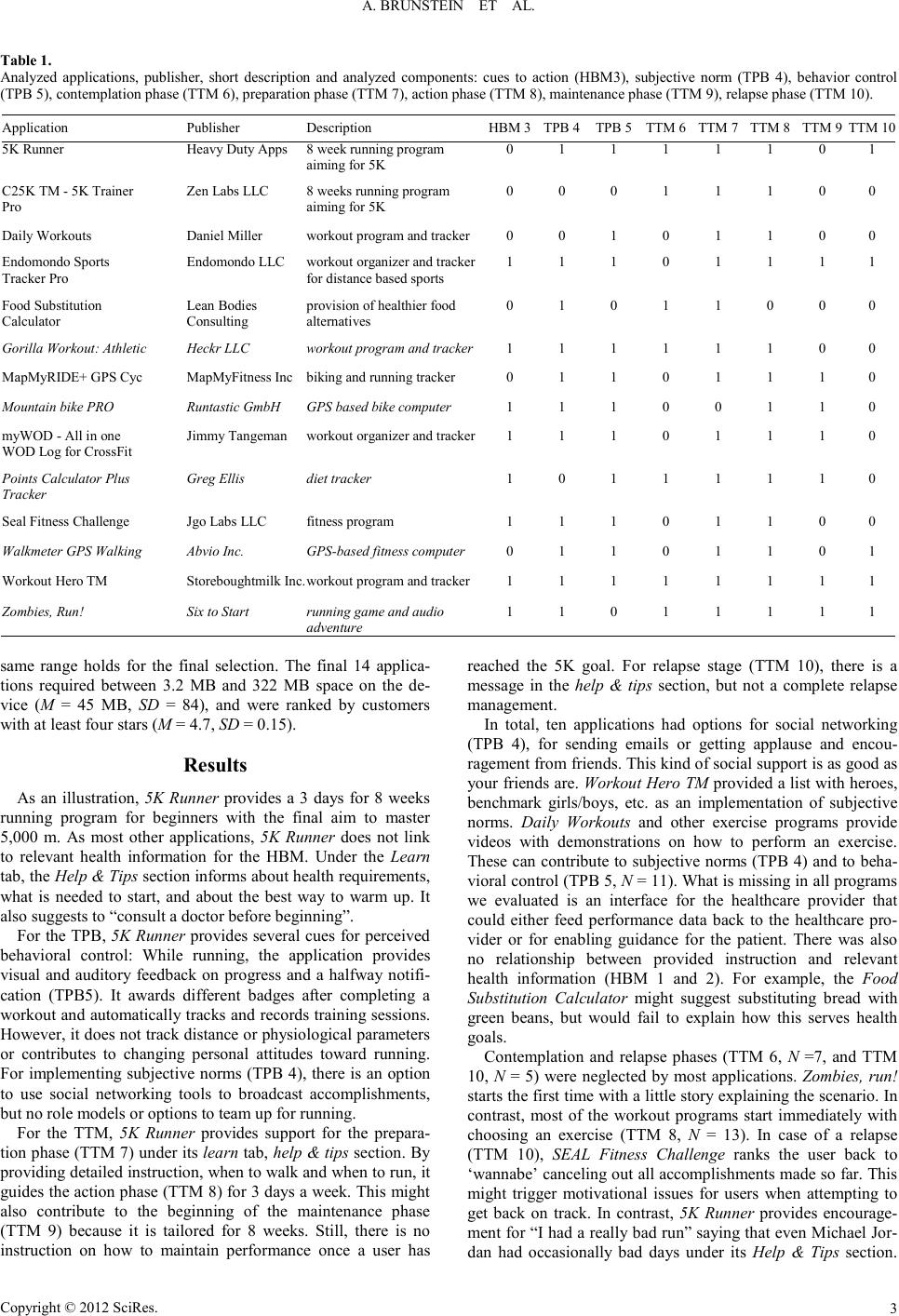 A. BR UNS TEIN ET AL. Copyright © 2012 SciRes. 3 Tabl e 1. Analyzed applications, publisher, short description and analyzed components: cues to action (HBM3), subjective norm (TPB 4), behavior control (TPB 5), contemplation phase (TTM 6), preparation phase (TTM 7), action phase (TTM 8), maintenance phase (TTM 9), relapse phase (TTM 10). Application Publisher Description HBM 3 TPB 4 TPB 5 TTM 6 TTM 7 TTM 8 TTM 9 TTM 10 5K Runner Heavy Duty Apps 8 week running program aiming for 5K 0 1 1 1 1 1 0 1 C25K TM - 5K Trainer Pro Zen Labs LLC 8 weeks running progra m aiming for 5K 0 0 0 1 1 1 0 0 Daily Workouts Daniel Miller workout program and tra cker 0 0 1 0 1 1 0 0 Endomondo Sports Tracker Pro Endomondo LLC workout organizer and tracker for distanc e based s po r t s 1 1 1 0 1 1 1 1 Food Substituti on Calculator Lean Bodies Consulting provision of hea lthier food alternatives 0 1 0 1 1 0 0 0 Gorilla Workout: Athletic Heckr LLC workout program and tracker 1 1 1 1 1 1 0 0 MapMyRIDE+ GPS Cyc MapMyFitness Inc biking and running tra cker 0 1 1 0 1 1 1 0 Mountain bike PRO Runtastic GmbH GPS based b ik e c omputer 1 1 1 0 0 1 1 0 myWOD - All in one WOD Log for Cros sFit Jimmy Tangeman workout or ganizer and trac ker 1 1 1 0 1 1 1 0 Points Calculator Plus Tracker Greg Ellis diet tracker 1 0 1 1 1 1 1 0 Seal Fitness Challenge Jgo Labs LLC fitness pro g r a m 1 1 1 0 1 1 0 0 Walkmeter GPS Walking Abvio Inc. GPS-based fitness computer 0 1 1 0 1 1 0 1 Workout Hero TM Storeboughtmil k Inc. workout program and tra cker 1 1 1 1 1 1 1 1 Zombies, Run! Six to Start running game and audio adventure 1 1 0 1 1 1 1 1 same range holds for the final selection. The final 14 applica- tions required between 3.2 MB and 322 MB space on the de- vice (M = 45 MB, SD = 84), and were ranked by customers with at least four stars (M = 4.7, SD = 0.15). Results As an illustration, 5K Runner provides a 3 days for 8 weeks running program for beginners with the final aim to master 5,000 m. As most other applications, 5K Runner does not link to relevant health information for the HBM. Under the Learn tab, th e Help & Tips section informs about health requirements, what is needed to start, and about the best way to warm up. It also suggests to “consult a doctor before beginning”. Fo r the TP B, 5K Runner provides several cu es for perceived behavioral control: While running, the application provides visual and auditory feedback on progress and a halfway notifi- cation (TPB5). It awards different badges after completing a workout and automatically tracks and records training sessions. However, i t does not track dist ance or physiol ogical p arameters or contributes to changing personal attitudes toward running. For implementing subjective norms (TPB 4), there is an option to use social networking tools to broadcast accomplishments, but no role models or options to team up for running. For the TTM, 5K Runner provides support for the prepara- tion phase (TTM 7) under its learn tab, help & tips section. By providing detailed instruction, when to walk and when to run, it guides the action phase (TTM 8) for 3 days a week. This might also contribute to the beginning of the maintenance phase (TTM 9) because it is tailored for 8 weeks. Still, there is no instruction on how to maintain performance once a user has reached the 5K goal. For relapse stage (TTM 10), there is a message in the help & tips section, but not a complete relapse management. In total, ten applications had options for social networking (TPB 4), for sending emails or getting applause and encou- ragement from friends. This kind of social support is as good as your friends are. Workout Hero TM provided a list with heroes, benchmark girls/boys, etc. as an implementation of subjective norms. Daily Workouts and other exercise programs provide videos with demonstrations on how to perform an exercise. These can contribute to subjective norms (TPB 4) and to beha- vior al c on tro l (TP B 5, N = 11). What is missing in all programs we evaluated is an interface for the healthcare provider that could either feed performance data back to the healthcare pro- vider or for enabling guidance for the patient. There was also no relationship between provided instruction and relevant health information (HBM 1 and 2). For example, the Food Substitution Calculator might suggest substituting bread with green beans, but would fail to explain how this serves health goals. Contemplation and relapse phases (TTM 6, N =7, and TTM 10, N = 5) were neglect ed by most applications. Zombies, run! starts the first time with a little story explaining the scenario. In contrast, most of the workout programs start immediately with choosing an exercise (TTM 8, N = 13). In case of a relapse (TTM 10), SEAL Fitness Challenge ranks the user back to ‘wannabe’ cancelin g out all accomplish ments made so far. This might trigger motivational issues for users when attempting to get back on track. In contrast, 5K Runner provides encourage- ment for “I h ad a reall y bad run” saying t hat even Mich ael Jor- dan had occasionally bad days under its Help & Tips section. 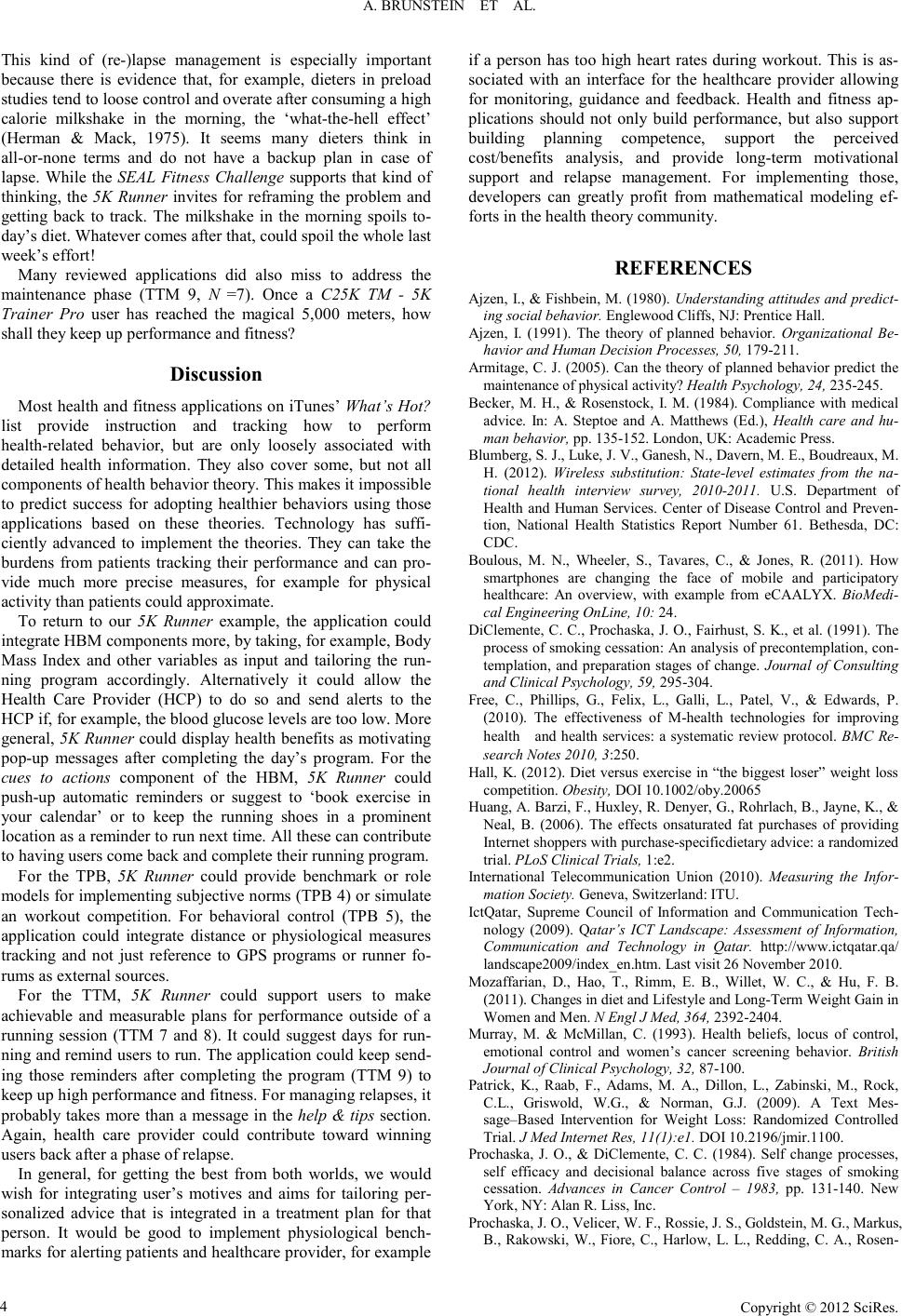 A. BR UNS TEIN ET AL. Copyright © 2012 SciRes. 4 This kind of (re-)lapse management is especially important because there is evidence that, for example, dieters in preload studies tend to loose control and overate after consuming a high calorie milkshake in the morning, the ‘what-the-hell effect’ (Herman & Mack, 1975). It seems many dieters think in all-or-none terms and do not have a backup plan in case of lapse. While the SEAL Fitness Challenge supports that kind of thinking, the 5K Runner invites for reframing the problem and getting back to track. The milkshake in the morning spoils to- day’s diet. Whatever comes after that, could spoil the whole last week’s effort! Many reviewed applications did also miss to address the maintenance phase (TTM 9, N =7). Once a C25K TM - 5K Trainer Pro user has reached the magical 5,000 meters, how shall they keep up performance and fitness? Discussion Most health and fitness applications on iTunes’ What’s Hot? list provide instruction and tracking how to perform health -related behavior, but are only loosely associated with detailed health information. They also cover some, but not all components of health behavior theory. This makes it impossible to predict success for adopting healthier behaviors using those applications based on these theories. Technology has suffi- ciently advanced to implement the theories. They can take the burdens from patients tracking their performance and can pro- vide much more precise measures, for example for physical activity than pati ents could app r oximate. To return to our 5K Runner example, the application could integrate HBM components more, by taking, for example, Body Mass Index and other variables as input and tailoring the run- ning program accordingly. Alternatively it could allow the Health Care Provider (HCP) to do so and send alerts to the HCP if, for example, the blood glucose levels are too low. More general, 5K Runner could display health benefits as motivating pop-up messages after completing the day’s program. For the cues to actions component of the HBM, 5K Runner could push-up automatic reminders or suggest to ‘book exercise in your calendar’ or to keep the running shoes in a prominent location as a reminder to run next ti me. All th ese can con tr ib ute to having users come back and complete their running program. For the TPB, 5K Runner could provide benchmark or role models for implementing subjective norms (TPB 4) or simulate an workout competition. For behavioral control (TPB 5), the application could integrate distance or physiological measures tracking and not just reference to GPS programs or runner fo- rums as external sources. For the TTM, 5K Runner could support users to make achievable and measurable plans for performance outside of a running session (TTM 7 and 8). It could suggest days for run- ning and remind users to run. The application could keep send- ing those reminders after completing the program (TTM 9) to keep up high performance and fitness. For managing relapses, it probably takes more than a message in the help & tips section. Again, health care provider could contribute toward winning users b ack after a phase of relapse. In general, for getting the best from both worlds, we would wis h for integrating user’s motives and aims for tailoring per- sonalized advice that is integrated in a treatment plan for that person. It would be good to implement physiological bench- marks for aler tin g p atien ts an d heal th care p rovi der, for exa mple if a person has too high heart rates during workout. This is as- sociated with an interface for the healthcare provider allowing for monitoring, guidance and feedback. Health and fitness ap- plications should not only build performance, but also support building planning competence, support the perceived cost/benefits analysis, and provide long-term motivational support and relapse management. For implementing those, developers can greatly profit from mathematical modeling ef- forts in the health theory community. REFERENCES Ajzen, I., & Fishbein, M. (1980). Understanding attitudes and predict- ing social be havior. Englewood Cliffs, NJ: Pren tice Hall. Ajzen, I. (1991). The theory of planned behavior. Organizational Be- havior and Human Decision Processes, 50, 179-211. Armitage, C. J. (2005). Can the theory of planned behavior predict the maintenance of physical activity? H ealth Ps yc ho l og y, 2 4, 235-245. Becker, M. H., & Rosenstock, I. M. (1984). Compliance with medical advice. In: A. Steptoe and A. Matthews (Ed.), Health care and hu- man behavior, pp. 135-152. London, UK: Academic Press. Blumberg, S. J., Luke, J. V., Ganesh, N., Davern, M. E., Boudreaux, M. H. (2012). Wireless substitution: State-level estimates from the na- tional health interview survey, 2010-2011. U.S. Department of Health and Human Services. Center of Disease Con trol and Preven- tion, National Health Statistics Report Number 61. Bethesda, DC: CDC. Boulous, M. N., Wheeler, S., Tavares, C., & Jones, R. (2011). How smartphones are changing the face of mobile and participatory healthcare: An overview, with example from eCAALYX. BioMedi- cal Engineering OnLine, 10: 24. DiClemente, C. C., Prochaska, J. O., Fairhust, S. K., et al. (1991). The process of smoking cessation: An analysis of precontemplation, con- templation, and preparation stages of change. Journal of Consulting and Clinical Psychology, 59, 295-304. Free, C., Phillips, G., Felix, L., Galli, L., Patel, V., & Edwards, P. (2010). The effectiveness of M-health technologies for improving health
and health services: a systematic review protocol. BMC Re- search Not es 20 1 0, 3:250. Hall, K. (201 2). Diet versus exer cise i n “the b iggest los er” weigh t loss competition. Obesity, DOI 10.1002/oby.20065 Huang, A. Barzi, F., Huxley, R. Denyer, G., Rohrlach, B., Jayne, K., & Neal, B. (2006). The effects onsaturated fat purchases of providing Internet shoppers with purchase-specifi c di et a ry ad v ic e: a ran d omi zed trial. PLoS Clinical Trials, 1:e2. International Telecommunication Union (2010). Measuring the Infor- mation So ci et y. Geneva, S witzerland: ITU. IctQatar, Supreme Council of Information and Communication Tech- nology (2009). Qatar’s ICT Landscape: Assessment of Information, Communication and Technology in Qatar. http://www.ictqatar.qa/ landscape2009/index_en.htm. Last visit 26 November 2010. Mozaffarian, D., Hao, T., Rimm, E. B., Willet, W. C., & Hu, F. B. (2011). Changes in diet and Lifestyle and Long-Term Weight Gain in Women and Men. N Engl J Med, 364, 2392-2404. Murray, M. & McMillan, C. (1993). Health beliefs, locus of control, emotional control and women’s cancer screening behavior. British Journal of Clinical Psychology, 32, 87 -100. Patrick, K., Raab, F., Adams, M. A., Dillon, L., Zabinski, M., Rock, C.L., Griswold, W.G., & Norman, G.J. (2009). A Text Mes- sage–Based Intervention for Weight Loss: Randomized Controlled Trial. J Med Internet Res, 11(1):e1. DOI 10.2196/ jmir.1100. Prochaska, J. O., & DiClemente, C. C. (1984). Self change processes, self efficacy and decisional balance across five stages of smoking cessation. Advances in Cancer Control – 1983, pp. 131-140. New York, NY: Alan R. Liss, Inc. Prochaska, J. O., Velicer, W. F., Rossie, J. S., Goldstein, M. G., Markus, B., Rakowski, W., Fiore, C., Harlow, L. L., Redding, C. A., Rosen- 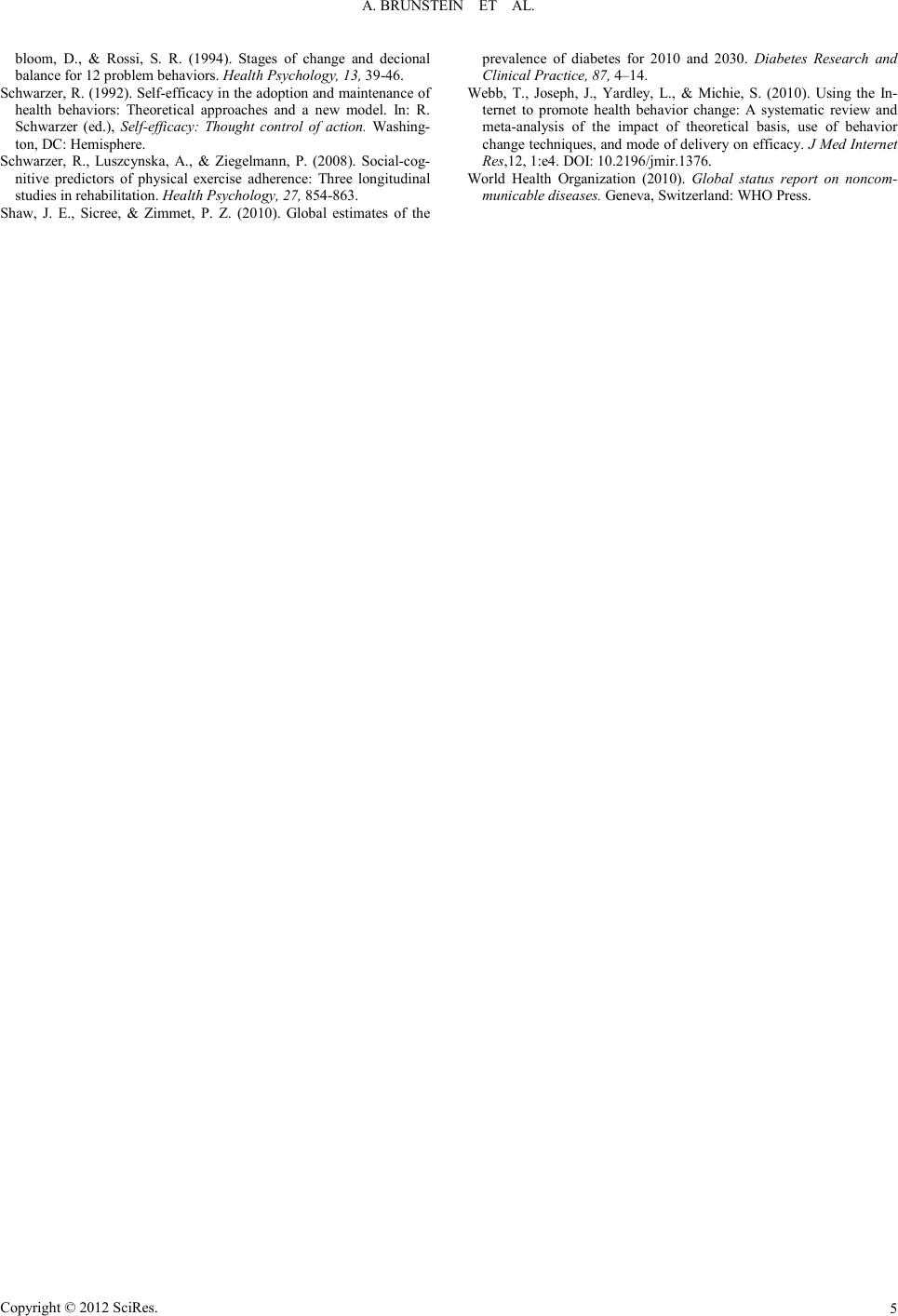 A. BR UNS TEIN ET AL. Copyright © 2012 SciRes. 5 bloom, D., & Rossi, S. R. (1994). Stages of change and decional balance for 12 problem behaviors. Health Psychology, 13, 39-46. Schwarzer, R. (1992). Self-efficacy in the adoption and maintenance of health behaviors: Theoretical approaches and a new model. In: R. Schwarzer (ed.), Self-efficacy: Thought control of action. Wa shing- ton, DC: Hem isph er e. Schwarzer, R., Luszcynska, A., & Ziegelmann, P. (2008). Social-cog- nitive predictors of physical exercise adherence: Three longitudinal studie s in re ha bilitation. Health Ps ychology, 27, 854-863. Shaw, J. E., Sicree, & Zimmet, P. Z. (2010). Global estimates of the prevalence of diabetes for 2010 and 2030. Diabetes Research and Clinical Practice, 87, 4–14. Webb, T., Joseph, J., Yardley, L., & Michie, S. (2010). Using the In- ternet to promote health behavior change: A systematic review and meta-analysis of the impact of theoretical basis, use of behavior ch ange techn iqu es, and mode of deliver y on effic acy. J M ed In tern et Res,12 , 1:e4. DOI: 10.2196/jm ir.1376. World Health Organization (2010). Global status report on noncom- municable diseases. Geneva, S witzer land: WHO Press . |

